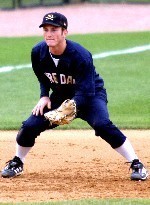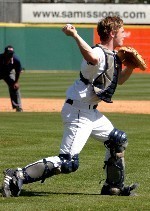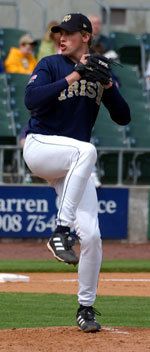Feb. 14, 2006
The Notre Dame baseball team traditionally has matched its stellar play on the field with strong performances in the classroom and that continued to be the case in the 2005 fall semester – as the 32 players combined for a 3.17 team grade-point average during the semester. The NCAA’s recently-released Graduation Success Rate (GSR) data also reinforced the Notre Dame baseball program’s elite academic standing, as the Irish were one of 17 teams among 268 in Division I – but one of only two teams from that group that also currently are in the national top-25 polls – to compile a 100-percent graduation rate, during a four-year sample of classes entering from 1995-98. The Irish also own a 100-percent graduation rate (63-of-63) among four-year players throughout the tenure of head coach Paul Mainieri (’95-present), with 12 others who signed professionally prior to their senior season returning to complete or near completion of their degree requirements.
Twenty-one of the Notre Dame baseball players posted a GPA of 3.0-plus during the 2005 fall semester, with 11 checking in at 3.4 or higher. The Notre Dame players also have combined for an impressive 3.10 cumulative team GPA over the course of their college careers.
Notre Dame boasts several strong Academic All-America candidates in 2006, most notably: senior lefthander Tom Thornton (3.54 cumulative GPA; as a double major in anthropology and film-television-and-theater), sophomore third baseman Brett Lilley (3.64; accounting), senior shortstop Greg Lopez (3.39; pre-professional studies and anthropology), senior leftfielder/DH Matt Bransfield (3.36; sociology) and junior catcher Sean Gaston (3.36; political science and history). Notre Dame’s unmatched Academic All-America history includes 20 honorees since 1992.

Sophomore third baseman Brett Lilley’s impressive start to his college career includes a 3.64 cumulative GPA, as an accounting major.
|
The senior class led the way for the Irish during the 2005 fall semester, averaging a 3.54 semester GPA that included seven players above a 3.4 and all eight posting a semester GPA of 3.05 or higher. Thornton (Middleboro, Mass.) posted a 3.75 for his fourth straight semester GPA above 3.70. The prospective medical-school student Lopez (Upper Arlington, Ohio) was next with a 3.71 semester GPA, followed by centerfielder Alex Nettey (3.69; management information systems major; Dolton, Ill.), leftfielder/DH Steve Andres (3.67; finance; Napa, Calif.), infielder Eddie Smith (3.54; Spanish; Olympia, Wash.) and Bransfield (3.53; Englewood, Colo.) all above the 3.50 mark. First baseman Craig Cooper (3.40; political science; Plainview, N.Y.) and rightfielder Cody Rizzo (3.07; sociology and international peace studies; Temecula, Calif.) rounded out the impressive academic showing by the senior class during the 2005 fall semester.
Gaston (3.33; Brownsburg, Ind.) and one of his classmates – righthander Jeff Samardzija (3.05; marketing; Valparaiso, Ind.) – also posted semester GPAs above 3.0 during the 2005 fall term, as did five members of the sophomore class: Lilley (3.71; North Canton, Ohio), catcher Chris Soriano (3.47; pre-professional studies; Randolph, N.J.), lefthander Wade Korpi (3.40; anthropology; Lake Worth, Fla.), second baseman Ross Brezovsky (3.20; economics; Naples, Fla.) and righthander Joey Williamson (3.08; political science and computer applications; Lantana, Fla.).

Prospective medical-school student Greg Lopez enters his final semester at Notre Dame with a 3.39 cumulative GPA.
|
Six members of the freshman class began their collegiate academic careers with semester GPAs of 3.0-plus: righthander David Phelps (3.33; Hazelwood, Mo.), infielder Evan Sharpley (3.20; Marshall, Mich.), righthander Brett Graffy (3.17; Homer Glen, Ill.), catcher Mike Many (3.17; Naperville, Ill.), third baseman Eddy Mendiola (3.07; Miami, Fla.) and righthander Kyle Weiland (3.00; Albuquerque, N.M.).
The GSR numbers recently released by the NCAA showed that the Irish baseball team was one of 16 Notre Dame varsity programs (out of 20 in the study) that compiled graduation rates of 100-percent during the four-year period of classes entering from 1995-98, with every Notre Dame team owning a GSR rate of at least 90-percent. The GSR was created to more accurately reflect actual graduation rates by including transfer data in the calculation. The graduation rate methodology used for the previous decade by the Department of Education counts all student-athletes who transfer from or leave an institution for any reason as non-graduates from their initial school, even if they leave in good academic standing.

Matt Bransfield was one of seven members of the senior class who posted a GPA of 3.4 or higher during the 2005 fall semester.
|
Under the previous methodology, the Notre Dame baseball program’s graduation rate of 87-percent still ranks 11th in all of Division I – with none of the 10 teams that own higher grad. rates (under the old formula) able to match Notre Dame’s status as a top-25 team in the national polls.
The Notre Dame athletic department’s overall GSR number of 98 percent was tops in Division I-A, with the national GSR average for Division I-A at 76 percent. Notre Dame also graded out second (behind the U.S. Naval Academy) is the traditional federally-mandated graduation rates study, at 90.4 percent.
Among the 119 NCAA Division I-A institutions, Notre Dame had the highest percentage of its sports with 100-percent scores, with a .800 figure (16 of 20).
The GSR was brought about after college and university presidents asked the NCAA to develop a new methodology that takes into account the mobility among students in today’s higher education environment. Research indicates that approximately 60 percent of all new bachelor’s degree recipients are attending more than one undergraduate institution during their collegiate careers.

Junior Sean Gaston has compiled a 3.36 cumulative GPA as a double major in political science and history.
|
The GSR is an analysis of more than 91,000 student-athletes while the most recent federal measurement – which did not count transfer students – was for 67,000 students.
The GSR should not be confused with another new NCAA initiative, the Academic Progress Rate, which uses a series of formulas related to student-athlete retention and eligibility to measure the academic performance of all participants who receive a grant-in-aid on every team at every NCAA Division I college and university.
In addition to the GSR, the NCAA will continue to compile data and release results based upon the federally-mandated methodology.







